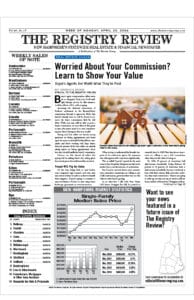
The overall plunge in residential loan activity across the state cut deeply into loan originators’ business last year. iStock illustration
Many mortgage loan officers found themselves working more for less last year in New Hampshire – and the same business pattern seems to be repeating itself in 2024.
New mortgage lending data shows that top New Hampshire residential loan originators saw huge declines in dollar volumes in 2023, compared to 2022, thanks to higher interest rates tamping down both the supply and demand for homes last year, along with refinance loans.
The volume declines in residential loans often exceeded 50 percent even for top mortgage-loan officers in the Granite State, according to data from The Warren Group, the real-estate data analytics firm and publisher of The Registry Review.
The top bank originator in New Hampshire in 2023 was Matthew Thomas, a mortgage loan officer at Merrimack County Savings Bank who handled $39.9 million in residential loans last year. But that was down 40 percent from his 2022 volume and down 51 percent from the top bank originator’s volume in 2022.
Meanwhile, the top credit union originator, Alexandra Elmasry of Granite State Credit Union, handled $20.2 million in loans in 2023, but that was down 50 percent compared to the volume of the state’s top credit-union performer in 2022, according to Warren Group data.
Among mortgage company originators, Mary Merrill at CMG Mortgage once again reigned supreme among her peers in 2023, handling $74.6 million in residential loans in 2023. That was down 3 percent from her top-ranked volume performance in 2022.
Who Are New Hampshire’s Top Loan Originators?
See our 2023 rankings to find out.
Part of Larger Trend
Last year’s performance by loan originators merely reflected the overall plunge in residential loan activity across the state and most of the country in 2023, as rising interest rates cut deeply into lending businesses of most institutions, whether they were banks, credit unions or mortgage companies.
One of the biggest lending hits came in the purchase mortgage category, as the inventory of homes for sale plunged to new record lows last year, caused mainly by potential sellers hesitating to put their homes on the market if it meant taking on higher interest rates when purchasing their alternative homes.
In the single-family mortgage category alone, for instance, Meredith Village Savings Bank was the top bank lender last year, posting $44.9 million in loans in 2023. But that figure was down by 36 percent compared to 2022, according to The Registry Review’s annual rankings of the state’s top lenders, published earlier this year.
Nonpurchase residential loan products – typically, refinances, home equity loans and home equity lines of credit (HELOCs) – saw similar downward trendlines in New Hampshire in 2023, with refinancings in particular way down at most institutions.
At $430 million, Citizens Finance ranked first in New Hampshire in non-purchase lending in 2023, but that was down 56 percent from the amount posted by the 2022 leader, Bank of America.
LOs Still Busy
The overall residential loan business may have been down last year for institutions and individual originators, but that didn’t mean loan officers were less busy.
Higher interest rates tamped down the enthusiasm of some would-be home purchasers. But demand still remained very strong – and many would-be buyers were still securing pre-approved mortgages last year.
Meanwhile, lending activity in other categories, such as HELOCs and construction loans, remained somewhat strong in 2023, at least compared to first mortgages and refi deals.
“It still felt just as busy, if not busier, last year,” said Lori Borrin, a mortgage loan officer and vice president at Meredith Village Savings Bank. “There was a lot of phone calls and work to do despite [volumes] being down.”
As for construction loans, they were down last year, but not to the extent as other loan categories, said Borrin. HELOC activity was also comparatively strong.
“We’re doing a lot of equity lines of credits,” said Borrin, who last year did $31.4 million in overall lending last year.
Borrin was the third-biggest loan originator in New Hampshire in 2023, according to The Warren Group’s data.
Thomas, of Merrimack County Savings Bank, agreed that construction, home equity and HELOC lending helped soften the blow of big declines in purchase and refi lending.
In particular, construction lending, though off by about a third in 2023, kept lenders busy last year, especially loans for renovations and new accessory dwelling units attached to homes. He noted that many older homeowners are building additions to their houses so they can live in them later while letting their adult children take over the original and larger portions of the homes.
“At least it’s been consistent,” Thomas said of construction lending in general. “It hasn’t been hurtling downward.”
Stacey Gagnon, senior mortgage originator at Triangle Credit Union in Nashua, said first-mortgage deals were “very, very slow” in 2023 due to the impacts of rising interest rates.
But lending activity started to pick up towards the end of last year, particularly for HELOCs.
“I’m seeing a lot more of them,” she said of lines of credit.
2024 Could See Repeat
As for the outlook for 2024, current conditions point to a possible repeat of 2023, especially if mortgage rates stay high and potential sellers stay on the sidelines for the rest of the year, some originators say.
In other words: no substantial changes in inventory levels are expected.
“[Potential] sellers are simply not willing to trade one house for another if it means an increase in mortgage rates for them,” Thomas said. “They’re not going to trade a 3 percent rate for a 7 percent rate. This is unprecedented territory we’re in.”
The market could improve if interest rates fall later this year. But recent remarks by senior leaders at the Federal Reserve suggest they could keep rate at current levels due to persistently high inflation.
“As rates go, so goes the market, up or down,” Thomas said.
The ultimate solution to the low-inventory problem is new construction of more homes, he stressed.
“The state is so far behind where we ought to be in terms of new homes,” said Thomas. “Lack of new construction is obviously causing huge inventory problems.”

